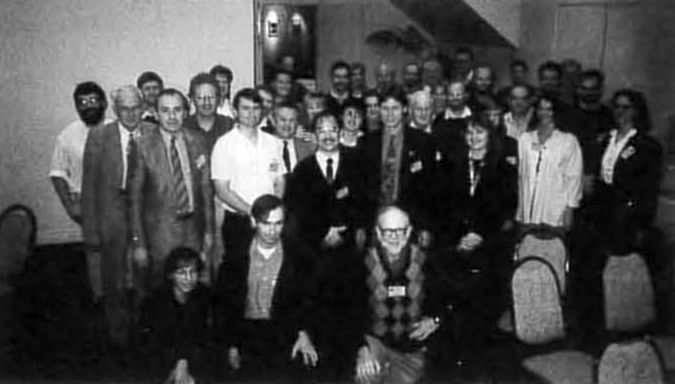


Meeting report
Materials Down Under
 Bemused AXAA Workshop participants watch Duax-look-alike photographer balance on table. Visible are Russian, English, German, New Zealand and a few Australian attendees.
Bemused AXAA Workshop participants watch Duax-look-alike photographer balance on table. Visible are Russian, English, German, New Zealand and a few Australian attendees.
A workshop on "Materials Characterization Using Rietveld Analysis of Diffraction Data" organized by the Victoria Branch of the Australian X-ray Analytical Association (AXAA Inc.) was held in Melbourne in April 1995. The workshop featured invited and contributed papers on the Rietveld Method for quantitative phase analysis, accurate lattice parameter determination, and lattice strain measurements. Five software packages were demonstrated.
R. Hill, IUCr Commission for Powder Diffraction chairman, opened the proceedings with a survey of the historical milestones of powder diffraction from profile fitting and the Rietveld Method, to the present state of the art. He discussed the need for improved profile descriptions and data weighting schemes. Invited speakers discussed the challenge of quantitative phase analysis, including startling results from such obscure (to the non-cognoscenti) effects as anomalous dispersion and microabsorption. E. Kisi explained why it might be easier to achieve accuracy and precision with neutrons, while B. O'Connor discussed the extent to which they have been achieved with X-rays. Although M. Hart promised a better way, a straw poll afterwards failed to identify a ready source of table-top synchrotrons. Contributed papers dealt with geological strata sequencing, mineral processing, ceramic fabrication, organometallic synthesis, and even a little crystallography. L. Cranswick expressed the opinion that the Rietveld Method would only be routine when it was built into an "expert system" which could make the decisions of a trained diffractionist.
The excellent venue, well organized computer demonstrations and exceptional "feeding" breaks afforded a friendly atmosphere and free exchange of ideas for which the organizers are be congratulated.
Martin J. Ryan and Graeme J. Gainsford

